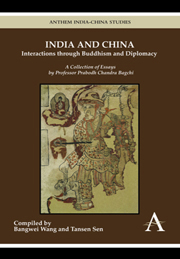 India and China: Interactions through Buddhism and Diplomacy
India and China: Interactions through Buddhism and Diplomacy Book contents
- Frontmatter
- Contents
- Compilers' Note
- Introduction (English and Chinese)
- Part One
- 1 Ancient Chinese Names of India
- 2 The Beginnings of Buddhism in China
- 3 Indian Influence on Chinese Thought
- 4 A Note on the Avadānaśataka and its Chinese Translation
- 5 Bodhisattva-śīla of Śubhākarasiṁha
- 6 A Fragment of the Kāśyapa Saṁhitā in Chinese
- 7 The Chinese Mysticism
- 8 Some Early Buddhist Missionaries of Persia in China
- 9 Some Letters of Hiuan-Tsang and his Indian Friends
- 10 New Lights on the Chinese Inscriptions of Bodhgayā
- 11 A Buddhist Monk of Nālandā amongst the Western Turks
- 12 Political Relations between Bengal and China in the Pathan Period
- 13 Chinese Coins from Tanjore
- 14 Report on a New Hoard of Chinese Coins
- 15 Ki-pin and Kashmir
- 16 Sino-Indian Relations – The Period of the United Empires (618–1100 A.D.)
- Part Two Short Articles
- Part Three Articles in Bengali
- Appendix
- Index
10 - New Lights on the Chinese Inscriptions of Bodhgayā
from Part One
Published online by Cambridge University Press: 05 March 2012
- Frontmatter
- Contents
- Compilers' Note
- Introduction (English and Chinese)
- Part One
- 1 Ancient Chinese Names of India
- 2 The Beginnings of Buddhism in China
- 3 Indian Influence on Chinese Thought
- 4 A Note on the Avadānaśataka and its Chinese Translation
- 5 Bodhisattva-śīla of Śubhākarasiṁha
- 6 A Fragment of the Kāśyapa Saṁhitā in Chinese
- 7 The Chinese Mysticism
- 8 Some Early Buddhist Missionaries of Persia in China
- 9 Some Letters of Hiuan-Tsang and his Indian Friends
- 10 New Lights on the Chinese Inscriptions of Bodhgayā
- 11 A Buddhist Monk of Nālandā amongst the Western Turks
- 12 Political Relations between Bengal and China in the Pathan Period
- 13 Chinese Coins from Tanjore
- 14 Report on a New Hoard of Chinese Coins
- 15 Ki-pin and Kashmir
- 16 Sino-Indian Relations – The Period of the United Empires (618–1100 A.D.)
- Part Two Short Articles
- Part Three Articles in Bengali
- Appendix
- Index
Summary
Chavannes was the first to publish an authoritative reading of the five Chinese inscriptions found at Bodhgayā with translation and notes (Les Inscriptions Chinoises de Bodhgayā, Revue de l'Histoire des Religions, T. XXXIV, Paris, 1896). His readings were based on estampages and photographs sent by Prof. A. Foucher who was then in India on a scientific mission. A faulty reading and a summary of two of these inscriptions had been previously published by Beal (J.R.A.S. 1881, vol. XIII, pp. 552–572, Indian Antiquary X, p. 193). The same note was reproduced without any revision in Cunningham's Mahahodhi. The original of the first four of the five inscriptions studied by Chavannes are now in the Indian Museum at Calcutta.
A re-examination of the original of Inscription no. 1 has now made it possible to suggest some improvements on its reading as given by Chavannes. The stone not being in a good condition the estampages was not evidently clear enough and Chavannes was obliged to leave a few lacunae in his reading of the inscription. These lacunae have now been filled up by an examination of the original inscription. The correct reading and a revised translation are given below.
Translation
The monk Che-yi of the great Han country had first taken the vow to exhort three hundred thousand men to practise the conduct which assures a higher birth, to make a charity of three hundred thousand copies (lit. fasciculi) of the Shang sheng king (Sūtra on the higher birth), and himself to recite (it) three hundred thousand times (lit. fasciculi).
- Type
- Chapter
- Information
- India and China: Interactions through Buddhism and DiplomacyA Collection of Essays by Professor Prabodh Chandra Bagchi, pp. 101 - 104Publisher: Anthem PressPrint publication year: 2011
